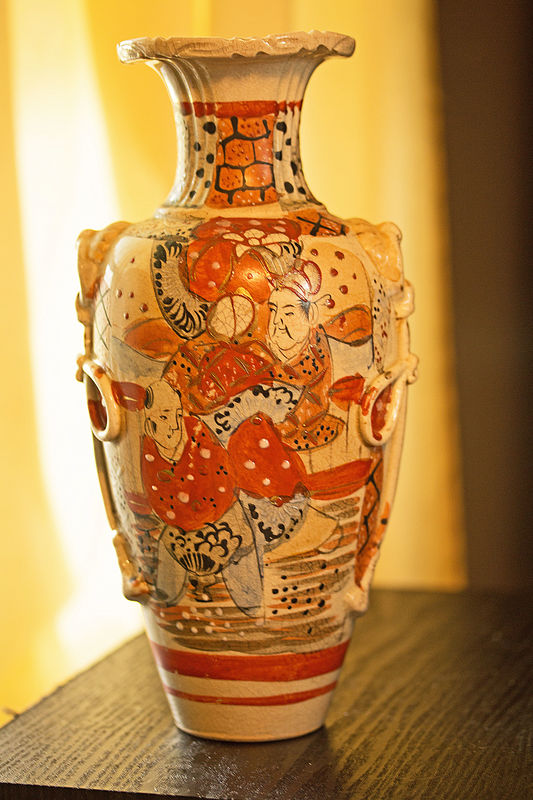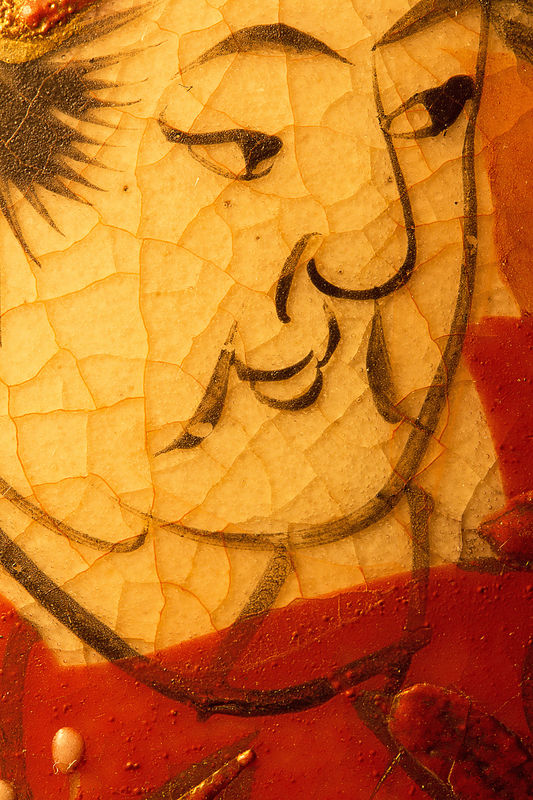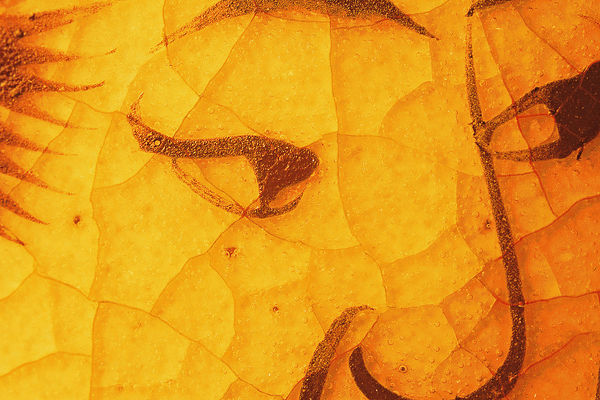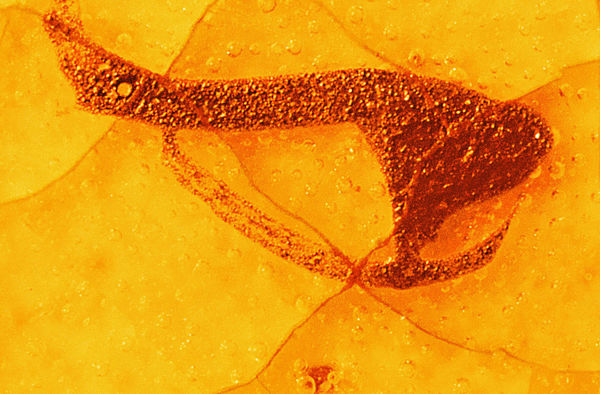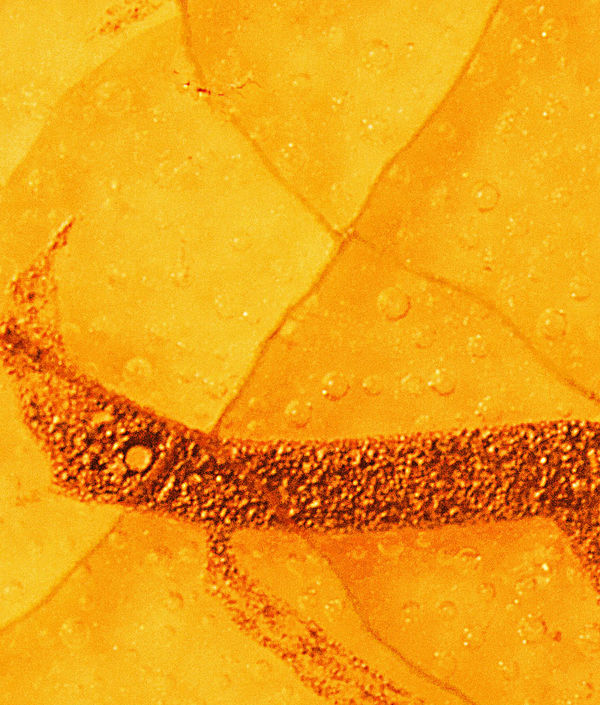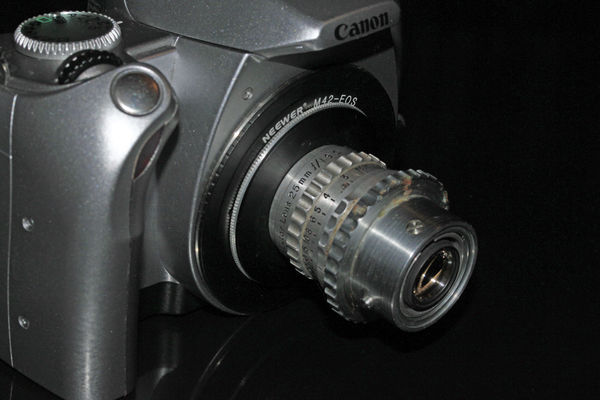Macro with Kodak Cine lens
Sep 18, 2017 23:16:05 #
This is probably not new for many of you, and I read about it years ago, but only recently decided to try it. One of the most highly recommended lenses for straight macro work in textbooks is the Kodak 25mm 1.9, contrived to fit large format. Awhile back, I had S. K. Grimes make an adapter to attach the front of the lens to view cameras with a #1 Copal lens board hole (thus mounting the lens backwards on the camera). It is common enough to mount any lens in reverse for macro, and adapters for most cameras are available. This lens model was used to shoot the cover of Kodak's Workshop Tech book, Photomacrography/Photomicography--it had a tiny beetle filling an 8x10 film, so I could use this on an 8x10 camera with a Packard shutter--or fix a Canon digital to the back of any view camera. If you go to eBay you can see a few of these lenses for sale--the demand keeps them around $400 just for the lens. Since it is made for movies, it is meant to take a small sensor or film and enlarge it tremendously to the screen--high resolution, contrast, etc. You may find one in fine shape for less--I did, but the work from Grimes was several hundred.
I have so far not got around to using it for anything but a 4x5 camera, that was just for play. But recently I added an adapter that lets the #1 connector fit M42 cameras; I have adapters for Canon to M42 (Pentax screw mount lenses). Here is a picture of the Kodak Cine lens mounted on a Canon film camera (EF lenses); I could use the Kodak on this camera for full frame with film, or on the 6450D digital for APS-C sensor, in which case the cropped sensor effectively increases magnification (macro is about 1:1 on the ff, and around 1.5:1 or 2:1 (about double life size on the sensor). Since the Kodak is f1.9, it is easier to focus than slower macros and most enlarging lenses (or process lenses at f9).
So here is a picture of the lens mounted to camera (at the end of the series here). For the first tests I tried a nice antique vase (Japanese Satsuma), and the shot of the whole vase used Canon digital with Canon 60mm EF-S 2.8 portrait/macro lens at non-macro distance (this is a better prime Canon lens for EF-S, not a kit zoom). Then is a canon lens picture of the vase as close as I could focus in the macro mode, so it is a very small section of the whole vase. Now we change to the Kodak 25mm f1.9 Cine lens. You see it is quite a bit closer than the closest Canon macro picture; you can see a difference in tonality, yes? The Kodak has excellent contrast and sharpness, but perhaps smoother rendition. Then I began to crop the same Kodak macro shot in Photoshop, in a series going down to extreme crop--note the remarkable sharpness, contrast, and resolution even at the highest blow-up. There was minimal editing to try and render the Canon lens picture and the Kodak lens picture in similar coloration, brightness, and contrast.
The Kodak picture used AV auto exposure with a cable release and open mirror lock-up with time-delay on tripod, with a floor lamp for light--with specular light from tiny macro/micro lighting sets (I don't have this), the resolution and contrast would be even more brilliant, though a bit of Photoshop was enough for this.
OK, you can get an extraordinary macro-only lens for what I wound up paying, maybe (used)--but I see them costing $4000 and up at B&H Photo. I think I might get similar results with a Kodak 50mm Cine lens (one of the most common sizes, much more common), for a lot less than the 25mm, and it would let me get twice as far from the item. I have used a Nikon 75mm enlarger lens on Canon camera with bellows attachment (years ago), with fine results, but I think this is sharper and certainly blows up better when squeezed.
p.s. I just noticed that the vase was turned around to the other side in the full-vase shot, so the face of the character seems reversed.
I have so far not got around to using it for anything but a 4x5 camera, that was just for play. But recently I added an adapter that lets the #1 connector fit M42 cameras; I have adapters for Canon to M42 (Pentax screw mount lenses). Here is a picture of the Kodak Cine lens mounted on a Canon film camera (EF lenses); I could use the Kodak on this camera for full frame with film, or on the 6450D digital for APS-C sensor, in which case the cropped sensor effectively increases magnification (macro is about 1:1 on the ff, and around 1.5:1 or 2:1 (about double life size on the sensor). Since the Kodak is f1.9, it is easier to focus than slower macros and most enlarging lenses (or process lenses at f9).
So here is a picture of the lens mounted to camera (at the end of the series here). For the first tests I tried a nice antique vase (Japanese Satsuma), and the shot of the whole vase used Canon digital with Canon 60mm EF-S 2.8 portrait/macro lens at non-macro distance (this is a better prime Canon lens for EF-S, not a kit zoom). Then is a canon lens picture of the vase as close as I could focus in the macro mode, so it is a very small section of the whole vase. Now we change to the Kodak 25mm f1.9 Cine lens. You see it is quite a bit closer than the closest Canon macro picture; you can see a difference in tonality, yes? The Kodak has excellent contrast and sharpness, but perhaps smoother rendition. Then I began to crop the same Kodak macro shot in Photoshop, in a series going down to extreme crop--note the remarkable sharpness, contrast, and resolution even at the highest blow-up. There was minimal editing to try and render the Canon lens picture and the Kodak lens picture in similar coloration, brightness, and contrast.
The Kodak picture used AV auto exposure with a cable release and open mirror lock-up with time-delay on tripod, with a floor lamp for light--with specular light from tiny macro/micro lighting sets (I don't have this), the resolution and contrast would be even more brilliant, though a bit of Photoshop was enough for this.
OK, you can get an extraordinary macro-only lens for what I wound up paying, maybe (used)--but I see them costing $4000 and up at B&H Photo. I think I might get similar results with a Kodak 50mm Cine lens (one of the most common sizes, much more common), for a lot less than the 25mm, and it would let me get twice as far from the item. I have used a Nikon 75mm enlarger lens on Canon camera with bellows attachment (years ago), with fine results, but I think this is sharper and certainly blows up better when squeezed.
p.s. I just noticed that the vase was turned around to the other side in the full-vase shot, so the face of the character seems reversed.
Sep 19, 2017 06:47:34 #
Sep 19, 2017 08:50:34 #
Charles, Thank you for sharing and rekindle old interests and memories. The world of the small is very interesting. In the 60's I did some SEM, Scanning Electron Microscope, work with Tire Fiber failure... a different world.
I have an Intel/Matell, yes toy, USB microscope. Problem is that the software was not updated beyond XP. Many years ago.. 2000.. I actually recommended one of these to a Australian company, the owner got one and emailed the photo of the etched metal and I diagnosed the problem. While passed off as a toy it was actually a useful tool for science.
Found interesting reading on camera microscope coupling:
http://www.boxvalley.co.uk/nature/cladocera/artphotomicro.asp
I have an Intel/Matell, yes toy, USB microscope. Problem is that the software was not updated beyond XP. Many years ago.. 2000.. I actually recommended one of these to a Australian company, the owner got one and emailed the photo of the etched metal and I diagnosed the problem. While passed off as a toy it was actually a useful tool for science.
Found interesting reading on camera microscope coupling:
http://www.boxvalley.co.uk/nature/cladocera/artphotomicro.asp
Sep 19, 2017 09:04:14 #
RWR
Loc: La Mesa, CA
Charles 46277 wrote:
This is probably not new for many of you, and I re... (show quote)
My setup is similar. I adapted a 25 f/1.4 Kern C Switar from a Bolex movie camera to screw into a T-2 adapter for use on any of my 35mm cameras. Mounted directly on the camera, magnification is 2.52X, lens-to-subject distance is 23.8mm. Rather than crop, I increase the magnification with extension tubes or bellows.
Image quality is similar to that of Leica Milar, Photar or Summar lenses.
Sep 19, 2017 09:46:43 #
cactuspic
Loc: Dallas, TX
I have used the lens mounted on bellows for high magnification work Because the depth of field is so thin, you may be interested in learning focus stacking.
Sep 19, 2017 09:58:41 #
Thanks--good to know. I think your calculation is better than mine--I suspected at a glance that the magnification was over 2:1, and you say 2.51:1. I have extension tubes (and can use the lens on a view camera with bellows and the digital camera on the back), but that is going well into microphotography--one might say, "quantum photography." Clearly you are right to use extension rather than cropping for a closer look. As a general rule, it is better to enlarge in the camera rather than in the darkroom or lightroom later. I suspect that these lenses will not show deterioration of the image until the magnification reaches perhaps 5:1 or more. Any news about that? I think the micro lenses you mention may be meant to go to 10:1. But your 25mm and mine cover all the quantum photography we want, quite well. I cropped here just to see how much it could stand.
The 25mm f1.4 Kern sounds like a jewel, and the extra light from f1.4 would be welcome in high magnification, but a textbook I read said f2 or thereabouts (1.9) is ideal because it gives good light but none of the loss in quality that faster lenses than that might have (typically with more elements). In any case, at 1:1 magnification (or anything more than 1:3), the image projected onto the sensor is much bigger than the sensor--any loss in quality around the edges is outside the picture. And of course the lens is stopped down for the shot.
How far do you stop down for macro with digital as a rule (or is there a rule)? On 35mm film, I used to stop down a Nikon enlarger lens on the camera to f32 or f45 for the depth of field, and with bellows extension this was more like f64. There was very minimal degradation from diffraction in shots of flowers, with pretty good depth of field for the situation. The Kodak Cine 25mm stops down to f22, quite far for small film or small sensor. I would say for flat (or near-flat) subjects such as the vase, f11 is far enough, but considering that the effective aperture there is probably f22 due to extension, maybe I should try f8 or f5.6...
The 25mm f1.4 Kern sounds like a jewel, and the extra light from f1.4 would be welcome in high magnification, but a textbook I read said f2 or thereabouts (1.9) is ideal because it gives good light but none of the loss in quality that faster lenses than that might have (typically with more elements). In any case, at 1:1 magnification (or anything more than 1:3), the image projected onto the sensor is much bigger than the sensor--any loss in quality around the edges is outside the picture. And of course the lens is stopped down for the shot.
How far do you stop down for macro with digital as a rule (or is there a rule)? On 35mm film, I used to stop down a Nikon enlarger lens on the camera to f32 or f45 for the depth of field, and with bellows extension this was more like f64. There was very minimal degradation from diffraction in shots of flowers, with pretty good depth of field for the situation. The Kodak Cine 25mm stops down to f22, quite far for small film or small sensor. I would say for flat (or near-flat) subjects such as the vase, f11 is far enough, but considering that the effective aperture there is probably f22 due to extension, maybe I should try f8 or f5.6...
Sep 19, 2017 10:19:24 #
Cactuspic, you are right to suggest focus stacking for more depth--I did not think of that. This is an option with digital that was not an option with film (or not practical for amateurs). Even the flat surface of the vase here has depth when magnified this much, or beyond--the paint is quite thick, relatively speaking, so the crackling in the porcelain surface is on a different plane from the paint surface. That may explain why the cracks are softer, while the bubbles are still nearly sharp. (Bubbles are in the finish--not water on the vase.)
We also have the advantage in digital of viewing the image on a larger screen than a viewfinder--and on the Canon 650D I can enlarge the screen image for fine focusing (the button on the upper right corner of the camera back, when using live-focus mode). This is the equivalent of the magnifying loupe used on the ground glass image of a view camera.
We also have the advantage in digital of viewing the image on a larger screen than a viewfinder--and on the Canon 650D I can enlarge the screen image for fine focusing (the button on the upper right corner of the camera back, when using live-focus mode). This is the equivalent of the magnifying loupe used on the ground glass image of a view camera.
Sep 19, 2017 10:49:21 #
cactuspic
Loc: Dallas, TX
In Lefkowitz's "The Manual Of Close-Up Photography," he discussed use of reversed cine lenses. He suggests that the suggested minimum magnification of the reversed cine lens is equal to the film size the lens was meant to cover. Therefore he suggests that the minimum magnification of lenses from an old 8mm film is 7x; from Super-8 cameras is 6x, and from 16mm equipment (which I believe the Kodak to be) is 4x. At these magnifications, diffraction exacts a large toll and caution should be used in stopping down. For this reason, the lenses are usually shot wide open or one stop down depending upon the optical quality of the lens. Stopping down at these magnification truly softens the image without increasing the depth of field. Enjoy...it a fascinating area of photography.
Sep 19, 2017 15:32:23 #
Sep 19, 2017 18:09:05 #
cactuspic wrote:
In Lefkowitz's "The Manual Of Close-Up Photog... (show quote)
Yes, this 25mm Kodak lens is for 16mm film--one-fourth the size frame of 35mm film. If the shooting magnification is 4:1 (four times life size on the sensor or film), which is what I mean by magnification, that is getting into the edge of microphotography, yes? But you say "minimum magnification"--do you mean that if I go to 5 or 10 times life size with more extension, it is fine or actually better?
I don't doubt your word that stopping down to small apertures would not add much depth of field at extreme magnifications, but stopping down flower close-ups (closer than normal lenses but not near 1:1--say. 1/3 to 1/10) does make a difference in depth of field. It could be acceptable to have the anthers slightly soft if it makes the front and back of the flower in better focus (if that is wanted), especially in a large print seen on a wall, standing back a bit. We seldom have the luxury of deciding where the viewer must stand when looking at our pictures, but sometimes we can. (Put wide angle shots in a narrow hallway where people have to see them close up, and telephoto pictures behind a sofa with coffee table, where people see them from farther back.)
Sep 19, 2017 19:15:46 #
cactuspic
Loc: Dallas, TX
Charles, with regard to the value of stopping down on close-ups, I am in full agreement. Even when I am at 1x, I often stop down when overall sharpness is of greater importance to me than having the greatest sharpness at the plane of focus.
As you get to higher magnifications diffraction becomes a bigger factor. Lenses meant for higher magnifications, such as Zeiss luminars or microscope objectives tend not to have any aperture adjustment.
With regard to your cine lens, you should get good images at 4x and greater magnification. This does not mean the lens won't be good enough at 2x or 3x. It's just that the Sweet spot of the lens, when reversed is 4x or greater. I have had good reslts at magnifications up to 10x.
I have seen a number of heated "discussions" as to the definitions of macro and micro. I learned that close-up was less than 1x, macro is 1x to 20x, and micro was 20x or greater. But I try not to get hung up on definitions
As you get to higher magnifications diffraction becomes a bigger factor. Lenses meant for higher magnifications, such as Zeiss luminars or microscope objectives tend not to have any aperture adjustment.
With regard to your cine lens, you should get good images at 4x and greater magnification. This does not mean the lens won't be good enough at 2x or 3x. It's just that the Sweet spot of the lens, when reversed is 4x or greater. I have had good reslts at magnifications up to 10x.
I have seen a number of heated "discussions" as to the definitions of macro and micro. I learned that close-up was less than 1x, macro is 1x to 20x, and micro was 20x or greater. But I try not to get hung up on definitions
Sep 19, 2017 19:56:21 #
cactuspic wrote:
Charles, with regard to the value of stopping down... (show quote)
That is interesting--and good news. The lens can be great at anything over 4x magnification. I assume also that I might consider flipping around front-ways for close-ups with less magnification than that?
Your rule on this does not seem to care what the focal length of the lens is--just the format? Actually, in the zone from 1:3 down to 1:1, regular lenses with macro features should be good; or good symmetrical-design lenses with extension, should be all right, such as enlarging lenses or process lenses...
Sep 20, 2017 01:57:29 #
cactuspic
Loc: Dallas, TX
Charles 46277 wrote:
Your rule on this does not seem to care what the focal length of the lens is--just the format? Actually, in the zone from 1:3 down to 1:1, regular lenses with macro features should be good; or good symmetrical-design lenses with extension, should be all right, such as enlarging lenses or process lenses...
Caarles, I am not sure what rule you are referring to. If it is what constitutes what is close-up, macro, and micro then the textbook answer is: yes, it is a function of the degree of magnification and does not take into account the format. On a personal level, I have had a tough time construing the definitions so rigidly as I have shot many different format, often during the same session, such as when I shoot both my cropped sensor and my full frame. By strict definition, similarly framed pictures may be a macro on my full frame and a close-up on my cropped sensor. That never made much sense to me.
Since the image circle of your cine lens is small you will need a additional magnification just to fill the frame. While I have not tested the lens in a front forward position at those magnifications, i
suspect that it would be inferior to a reversed position. Absent testing though, it is just an educated guess.
In the .333x to 1x magnification range there are many solutions that will yield good results, ranging from regular lenses with "macro" settings ( rarely gets beyond 1:3 or 1:2 magnification), extension tube, diopters, and a macro lens (which yields the best results.) I have used enlarger lenses which I will reverse at 1x unless they are symmetrical (some aren't.) Some of them give excellent that rival results that rival that macro lenses .
Sep 20, 2017 08:02:20 #
RWR
Loc: La Mesa, CA
Charles 46277 wrote:
I suspect that these lenses will not show deterioration of the image until the magnification reaches perhaps 5:1 or more. Any news about that?
I’ve not gone more than about 10:1 with the Switar, but I believe the image quality will hold well beyond that.
Charles 46277 wrote:
... a textbook I read said f2 or thereabouts (1.9) is ideal because it gives good light but none of the loss in quality that faster lenses than that might have ...
Slower lenses generally do perform better for normal close up work, but the f/1.4 Switar reversed is nearly as sharp as the f/4.5 Leica Mylars and Summars. For the ultimate in resolution, contrast and color rendition, the latter two, and the Photars, are about as good as it gets.
Charles 46277 wrote:
How far do you stop down for macro with digital as a rule (or is there a rule)?
If I want detail in a particular area, I stop down to whatever it takes. If it’s a bit soft overall I can generally live with it. If it’s out of focus, it’s useless. Most of the time I shoot around f/11.0.
Sep 20, 2017 08:47:23 #
Folks,
Mark Goodman over at http://coinimaging.com and Robert O'Tool at https://www.closeuphotography.com have done some great work cataloging a variety of Macro and Micro type lens. Many are lenses not initially designated for this type of use, but adapted as Charles has done, with superb performance. Examples of a Nikon Film Scanner lens removed and mounted, reproduction lenses, microscope objectives, industrial measuring lenses, bellows lenses and traditional Macro lens are shown.
My hat's off to Mark and Robert for putting this information out for our use!!
One particularly interesting lens that is useful around 4X, is a very inexpensive microscope lens ($18 including shipping!!). The Generic Objective Plan 4/0.1 160/0.17 over at Robert's site. This is a microscope objective that requires an extension of 160mm for effective 4X magnification, so a bellows is necessary. I have one and it's quite good, amazingly good considering the price!! Make sure you get the correct one from Amscope, as many copies are around on eBay that are just worth just the $18!!
I could post an image taken with it, but this is Charles's thread so would need his OK first.
One caution before you visit these sites, make sure your wallet is full because it will soon be empty :>)
Best,
Mike
Mark Goodman over at http://coinimaging.com and Robert O'Tool at https://www.closeuphotography.com have done some great work cataloging a variety of Macro and Micro type lens. Many are lenses not initially designated for this type of use, but adapted as Charles has done, with superb performance. Examples of a Nikon Film Scanner lens removed and mounted, reproduction lenses, microscope objectives, industrial measuring lenses, bellows lenses and traditional Macro lens are shown.
My hat's off to Mark and Robert for putting this information out for our use!!
One particularly interesting lens that is useful around 4X, is a very inexpensive microscope lens ($18 including shipping!!). The Generic Objective Plan 4/0.1 160/0.17 over at Robert's site. This is a microscope objective that requires an extension of 160mm for effective 4X magnification, so a bellows is necessary. I have one and it's quite good, amazingly good considering the price!! Make sure you get the correct one from Amscope, as many copies are around on eBay that are just worth just the $18!!
I could post an image taken with it, but this is Charles's thread so would need his OK first.
One caution before you visit these sites, make sure your wallet is full because it will soon be empty :>)
Best,
Mike
If you want to reply, then register here. Registration is free and your account is created instantly, so you can post right away.

